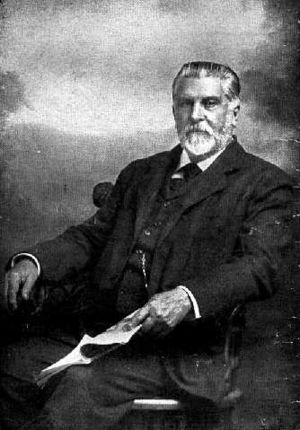Jabez Lamar Monroe Curry facts for kids
Quick facts for kids
Jabez Lamar Monroe Curry
|
|
|---|---|

Jabez Lamar Monroe Curry in 1901
|
|
| Personal details | |
| Born | June 5, 1825 Lincoln County, Georgia |
| Died | February 12, 1903 (aged 77) Asheville, North Carolina |
| Nationality | American |
Jabez Lamar Monroe Curry (June 5, 1825 – February 12, 1903) was an American politician and diplomat. He was also an officer in the Confederate States Army during the American Civil War. After the war, he became a strong supporter of free education in the Southern United States.
Contents
Early Life and Education
Jabez Lamar Monroe Curry was born in Lincoln County, Georgia, on June 5, 1825. His parents were Jabez and Rebecca Jordan Curry. He grew up in Alabama.
Curry went to the University of Georgia and graduated in 1843. Later, he studied at Harvard Law School. There, he was inspired by the ideas of Horace Mann. Mann believed that everyone should have access to free education. This idea greatly influenced Curry.
Public Service and Military Role
Curry served in the Mexican–American War. He was also a member of the Alabama State Legislature several times. From 1857 to 1861, he was a Democrat in the United States House of Representatives.
When the American Civil War began, Curry joined the Confederate States Army. He served as a lieutenant-colonel. He worked as a staff aide for important generals like Joseph E. Johnston and Joseph Wheeler.
Focus on Education
After the Civil War, Curry became a preacher. However, his main focus became promoting free education in the South. He traveled a lot, giving speeches and lectures. He pushed for better rural schools and a system of public schools.
Curry was the president of Howard College (now Samford University) from 1865 to 1868. After that, he taught history and literature at Richmond College in Virginia.
From 1881 until his death, he worked for the Peabody and Slater Funds. These funds helped schools in the South. He played a key role in starting the Southern Education Board. He also helped create the first normal school (a school for training teachers) in Virginia. Today, this school is known as Longwood University.
Diplomatic Career
Curry also had a career as a diplomat. From 1885 to 1888, he served as the United States' special envoy and minister to Spain. He returned to Spain in 1902 as an ambassador. This was for the coming-of-age celebration of King Alfonso XIII.
He wrote several books about education, American government, and Spanish history. He received many honors, including the Royal Order of Charles III of Spain.
Jabez Lamar Monroe Curry passed away on February 12, 1903. He is buried in Richmond, Virginia. His former home in Talladega, Alabama, called the J. L. M. Curry House, is now a National Historic Landmark.
His Legacy and Changing Views
Several places were named after Jabez Lamar Monroe Curry to honor his work.
- The Curry School of Education at the University of Virginia was named for him in 1905. This was part of a donation from John D. Rockefeller.
- Curry Hall dormitory at Longwood University and the Curry Building at the University of North Carolina at Greensboro are also named for him.
However, in recent years, there have been discussions about historical figures linked to the Confederacy. In 2020, the University of Virginia decided to remove Curry's name from its School of Education. This decision reflects changing views on honoring people who supported slavery and the Confederacy.
Curry's past speeches showed his support for slavery before the Civil War. He was also a member of the Confederate House of Representatives. These actions show his strong ties to the Southern cause.
Despite this, Curry also worked to promote education for Black people during the Reconstruction era. This was a time when many people did not share such ideals. However, it is important to note that he supported a more vocational (job-focused) style of education for Black students, different from what he promoted for white students.
Until 2009, one of Alabama's two statues in the United States Capitol's National Statuary Hall Collection honored Jabez Lamar Monroe Curry. This statue was created by Dante Sodini. In October 2009, it was replaced with a statue of Helen Keller. Curry's statue was then moved to Samford University. It was later returned to the Alabama Department of Archives and History.
Written Works
- Constitutional Government in Spain (1889)
- William Ewart Gladstone (1891)
- The Southern States of the American Union (1894)
- Difficulties, Complications, and Limitations Connected with the Education of the Negro (1895)
- Civil History of the Government of the Confederate States, with some Personal Reminiscences (1901)
Images for kids



